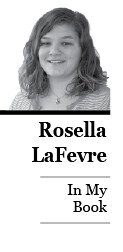Columnist Rosella LaFevre dives into “Speed Shrinking” and learns to be alone after leaving her best friend for college.
Leaving our high school lives behind for college means a lot of change – at least it did for me. A childhood spent on campus with a parent who works at Temple meant adjusting to college life wasn’t that hard.

Only, I hadn’t counted on how lonely I would be without my best friend. Adjusting to life without your support system is hard, as Julia Goodman, the narrator of Susan Shapiro’s touching first novel “Speed Shrinking” would tell you.
The novel opens with an announcement from her best friend, Sarah, that she will leave New York City after her wedding that weekend. That same day, Goodman’s husband Jake told her he was departing for TV work in Los Angeles, and at her weekly appointment, her beloved shrink Dr. Ness divulged plans to move to the Midwest.
With all three of her “pillars” leaving, Goodman, the Manhattan self-help author, is in a tizzy. What will she do without them?
I felt the same way when I said goodbye to my best friend Ashley when she left for nursing school, which is six hours away. For my first year at Temple, I would be living in the dorms, and I wished I could have had my best friend with me. The distance between Ashley and I seemed too much to bear, especially because I hate talking on the phone, and the idea of Skype is extremely unnerving.
Goodman started to feel like she was losing her mind that weekend when all of her supports decided to leave – at least that’s how Goodman saw it – and found herself lapsing into a sugar coma.
Here is a woman with a tendency to become addicted to just about anything – nicotine, alcohol, chewing gum, therapy – and who has made a career out of teaching others how to conquer their addictions. When she begins licking the icing off of the donuts at Sarah’s post-wedding brunch, Goodman can’t stop. Next, she’s eating pink Hostess Sno Balls at her computer, anxiously awaiting news from her best friend and shrink.
Goodman told Sarah’s therapist that Sarah’s departure was the hardest to deal with, adding it felt like a divorce.
It’s hard not to feel like you have gone through a divorce when your best friend lives far away and is making friends with new people and has trouble making time for you.
To deal with all of her losses and find a way to lose all of the weight gained as a result of her new sugar addiction, Goodman sees eight shrinks in eight days. Of these, she chooses one to continue seeing but “cheats” on him with e-consultations with Dr. Ness.
Throughout much of the book, she struggles to come to terms with her feelings of abandonment caused by Dr. Ness, who had not only been a surrogate father but a big part in the success of her first self-help book.
Like Goodman, I searched for ways to deal with the lack of a support system, but I never sought out a professional. As an author of self-help books, it seems funny it took Goodman almost the entire novel to realize she could survive the loss of her support system.
“Independence used to be my goal,” Goodman said in narration. “But I’ve come to believe the struggle of life is actually finding the right people to walk beside you.”
The anxious, loving, stronger-than-she-thinks heroine of Shapiro’s wonderfully entertaining novel is a lot like Shapiro, who got her start writing candid, passionate memoirs. In fact, the resemblances between Goodman’s life and Shapiro’s life are so striking that fans of her previous works may forget “Speed Shrinking” is a novel, but that’s a large part of its charm.
Although Goodman is in her late ‘30s, the narrator of Shapiro’s book has a lot in common with college students who feel anxious about being separated from their nearest and dearest.
It was with the help of the novel I came to realize my best friend’s departure, and the new life she’s built didn’t have to exclude me. Although it didn’t mean we were no longer friends, it did mean I needed to create my own new world.
Sometimes the people walking beside you can’t anymore, even if they want to, and sometimes they’re just walking a little further away. You might search for new people to walk with, as Goodman did, and this can be very rewarding. But sometimes, it’s good to walk alone for a while.
As Goodman learned, you don’t need to put on the “Freshman 15” to deal with being alone.
Rosella LaFevre can be reached at rosella.lafevre@temple.edu.


Be the first to comment